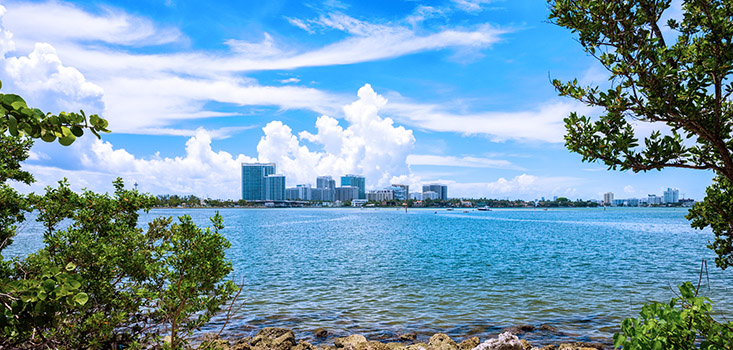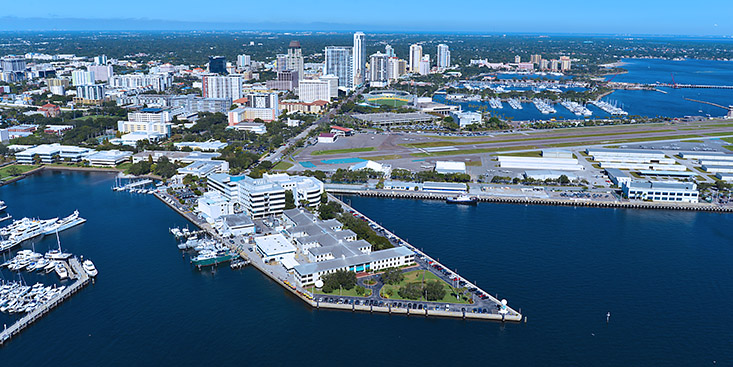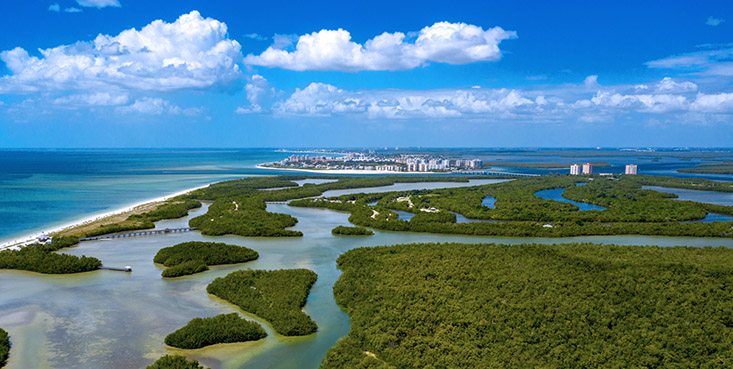Editor’s note (Oct. 6, 2022): We chose the lead image for this article (and published the article itself) prior to Hurricane Ian, which significantly damaged this very area – and many other communities across Florida and beyond. We stand by those impacted by this storm, which has further strengthened our commitment to the Flood Hub’s mission: improving flood forecasting and resilience in Florida.
By: Dyllan Furness, Science Communication Manager for the Florida Flood Hub for Applied Research and Innovation
From his office at the University of South Florida College of Marine Science, Tom Frazer can see the tide gauge at the edge of the Port of St. Petersburg. It’s a discreet device — a steel post with multiple sensors. Countless boaters have passed it unknowingly on their way in and out of Bayboro Harbor in St. Petersburg.
Tide gauges are key to understanding our changing coasts. Monitored by the National Oceanic and Atmospheric Administration (NOAA) since 1947, the St. Petersburg tide gauge records the water level multiple times per day, allowing researchers to monitor our coastline over time. Data from the St. Pete tide gauge show that local sea level has increased by about nine inches in 75 years. Tide gauge measurements from around the state, combined with satellite altimetry data, which scientists also use to monitor sea level, paint an even more complete picture.
“Sea level is rising along Florida’s coasts,” said Frazer, dean of the College of Marine Science and executive director of the Florida Flood Hub for Applied Research and Innovation. “We’re seeing effects on our shorelines, in developments, and through extreme weather events that raise questions about the vulnerability of our coastal and inland communities.”
How will rising seas affect people, businesses, and infrastructure? What areas are most vulnerable to tidal flooding and storm surge? Where will adaptation and mitigation investments have the greatest impact?
The Flood Hub was recently established by the state to help answer complex questions like these. Harnessing expertise from academia, governmental agencies, and private industry, the Flood Hub aims to foster resilience — empowering communities to prepare for, withstand, and rebound from flood events and other natural hazards. It’s an important step for Florida to better adapt to and mitigate the impacts of climate change.
In the near term, the Flood Hub will work closely with the Florida Department of Environmental Protection (DEP) as it conducts its statewide vulnerability assessment, and provide data to counties and municipalities to inform their planning efforts. Longer-term goals include engaging citizens through community-based monitoring programs, offering workforce development opportunities, and developing data visualization tools to better depict the impact of climate-related hazards.
At the heart of this effort are expert working groups assembled by the Flood Hub to address specific environmental concerns. These working groups evaluate data to improve our ability to forecast flooding events and inform science-based decisions by Florida’s policymakers, practitioners, and the public.
“Our goal is to promote actionable science that has real-world impact,” said Frazer. “That means advancing our knowledge and understanding of the environmental challenges we face as a state.”

Seagrapes and mangroves cling to the shores of Oleta River State Park in North Miami Beach. Sea level may increase by more than a foot along Florida’s Atlantic and Gulf coasts by 2050.
Sunshine gives Florida its nickname, but water is the state’s lifeblood. More thunderstorms soak Florida than any other state. Wetlands of the Everglades extend from coast to coast. And with 1,350 miles of coastline — more than any other state in the contiguous U.S. — Florida’s culture and economy are buoyed by the ocean.
But this proximity brings vulnerability. More than 76 percent of Floridians live in low-lying coastal areas, where even modest changes in sea level have consequences on land. By 2050, Florida’s Atlantic and Gulf coasts may experience more than a foot of sea level rise, according to a recent report by NOAA. Residents and businesses in coastal communities may experience more frequent and severe flooding during high tides, tropical storms, and hurricanes. Meanwhile, inland communities may see changes in rainfall patterns and stronger storms in the state’s interior.
“The climate is evolving and we’re still trying to figure out all the ways it will impact our daily lives,” said Gary Mitchum, associate dean for Research at the College of Marine Science and an expert on sea level rise.
Mitchum is Chair of the Flood Hub’s first working group on sea level rise. Comprised of experts from around the state and country, the working group is charged with developing sea level rise projections for use in DEP’s statewide vulnerability assessment.
“One of our group’s main focuses is collecting high-resolution data to improve flooding forecasts around the state,” said Mitchum. “The recent federal Sea Level Rise Technical Report created projections for the entire United States. It’s important for us to assess whether these national projections are appropriate for Florida’s coastlines, and whether there are regional differences within the state. This will allow us to better forecast how sea level rise will impact communities at the local level.”
This is just the beginning. Subsequent working groups will focus on better understanding changes in rainfall patterns and using advanced seafloor mapping techniques, which aid in the ability to predict storm surge. Others will look at groundwater levels, natural and built infrastructure such as stormwater systems, and more. Their focuses may differ, but each working group is designed to be nimble and responsive to statewide needs, while supporting the development of data products for scientists and non-scientists alike.
"The Flood Hub bridges the gap between academia, private industry, the government, and the public,” said Frazer. “Our model is intended to remove the silos that can sometimes limit scientific impact. By employing science and policy liaisons who will work closely with practitioners and policymakers, we’ll ensure our work is accessible to a variety of stakeholders.”
Through improved data products and real-time flood forecasting, the Flood Hub will give decision-makers access to the latest science and guide resiliency efforts to protect people, businesses, natural resources, and critical infrastructure.

An aerial view of the University of South Florida College of Marine Science.
Standing on the seawall at the College of Marine Science, Florida’s connection to the ocean comes into focus. High tide can make it feel like ground zero for sea level rise. In the age of climate change, waves carry an urgent reminder that Florida has always been shaped by water.
The college is a fitting home for the Flood Hub.
“Our faculty expertise puts us in a strong position to investigate issues related to climate change,” said Frazer, adding that the Flood Hub won’t have to tackle these issues alone. “While based at USF, the Flood Hub serves all of Florida and engages experts from around the globe. We’ll be able to leverage our strong partnerships to yield value for communities across the state.”
It's all part of the Flood Hub’s mission to help fortify Florida against some of the state’s most pressing environmental challenges.
“Florida is unique in many ways,” said Frazer. “We’re a low-lying peninsula, our land heats up rapidly, and we have winds that originate in the Gulf of Mexico and Atlantic Ocean. These factors create scenarios that make global and national climate models inadequate for Florida. The Flood Hub will help us better forecast and prepare for flooding events and put Florida in a more resilient position for the future.”
